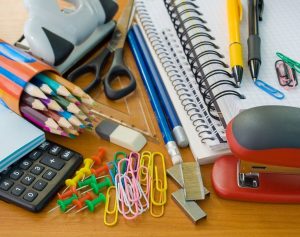
Did the end of the school year leave your home cluttered with papers, bags, and an avalanche of artwork? If your home is filled to the max with school supplies, take a look at how self-storage can help.
Artwork
Your fridge only has so much space. Rather than display everything your child brings home at the end of the school year, store it.
Throwing away precious paintings, drawings, and other projects isn’t always an option. You want to hold on to these mementos forever. But you also don’t want to clutter your basement, attic, crawl space, or cabinets. Before you store:
- Organize everything. Some day you may need to retrieve some of your child’s old artwork. A well-organized storage stash makes it easy to find the items. Create your own system, and organize the art by year, type, season, or another category.
- Use plastic baggies. Place fragile artwork (such as sculptures or collages) into zipper-top plastic baggies. If part of the art falls off, the baggie will catch it.
- Choose bins. Plastic bins (with tight-fitting lids) can secure your child’s art and keep it safe from moisture, dirt, and other debris.
- Inventory everything. Create an inventory, and list what you’re storing and where. This will help you to locate items later on.
You don’t need to hold on to each and every piece of art your child makes from preschool through high school. To save space in your rental unit, photograph some of the artwork instead of storing it.
School Supplies
Does your child have notebooks, pens, and pencils leftover from last year? If the items are still usable (or completely unused), store them over the summer in your rental unit. Not only does this save space at home, but it gives you a jump-start on next school year’s shopping list.
To store excess school supplies:
- Keep everything together. Chances are your child didn’t bring home several boxes-worth of crayons and construction paper. Condense the leftovers into one box or bin to make it easy to find everything next fall.
- Bag individual items. Even though keeping everything together is an easy organizational strategy to follow, you may also want to separate individual items. Use plastic zipper baggies to keep pens, pencils, crayons, paper clips, or anything else separate within the same box or bin.
- Use a backpack. If your child’s school bag is in usable shape, keep it for next year, and simply store everything in the backpack.
- Inventory everything. A full list of leftover supplies makes back-to-school shopping easier.
While saving barely used supplies (such as almost-empty notebooks) can save you money and time, you don’t need to store everything in your child’s end-of-the-year backpack. Throw away or recycle mostly used notebooks, pencil nubs, broken crayons, and anything else you’re likely to replace next fall.
Electronic Items
Older kids may have electronic devices they use only for school. Whether your child has a school-use-only tablet or any other device, follow these tips for storing your child’s unused electronics:
- Pack in the original boxes. If you still have the original packaging, use it for storage to keep the item safe and secure over the summer.
- Wrap in protective material. Use bubble wrap, towels, newspaper, or another protective material to reduce breakage risks.
- Review the manual. Read the device’s owner manual for storage procedures. This may include removing the battery from the electronic item.
- Choose climate control. If possible, store the item in a climate-controlled unit. This reduces the risks associated with humidity damage.
Along with packing wisely, never store other items on top of your child’s electronics. The pressure from boxes or bins can seriously damage the devices.
Do you need to rent a self-storage unit? Contact Sentry Mini-Storage Inc. for more information.
